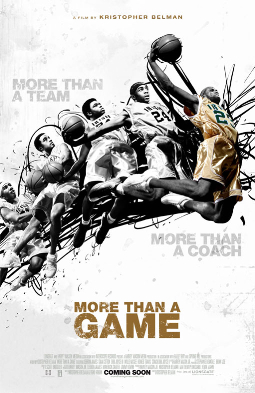A Family Unlike Any Other

This review was written for the OCJEA 2014 Write-Off about More than a Game, a 2008 documentary that follows five young basketball players (including Lebron James) called the Akron Fab Five. The piece won 2nd place in Critical Reviews.
More than a Game is not a documentary about basketball, or a high school team, or the trials of adolescence. It shows the bravest, strongest family of brothers the world of high school athletics will ever see. As the film starts, we see a fully black screen and hear only the voices of the players and the sounds of the court. We fully feel the heartbeat of basketball and how it courses through the blood of the players.
More than a Game is a film that follows LeBron James and four of his teammates through their high school basketball careers, but it is really so much more than that.
The film becomes unlike regular sports films almost right away. Writers Kristopher Belman and Kevin Mann take care to portray the intricacies of each man’s story so that we understand the team from a more human perspective. We thus automatically root for the little guy Dru Joyce, the relentless celebrity and early poverty of LeBron James, and the brotherhood and love between the men that creat a family both on and off the court.
“We became close, endured our circumstances together,” James said of the team, as the camera closed in tightly on his face, “Basketball was our home away from home.”
Director Kristopher Belman took care to show the world how much basketball meant to the kids of St. Vincent and Mary’s and how much it means to the world, focusing on each man’s face so that we could see through their athletic exterior and into their souls. Though LeBron James, the team’s star player, often had to move around and never really developed many close friendships with other kids, he said of his team, “I found friendship in basketball, and no matter what happened outside I decided these are the guys I would be loyal to, these are my four best friends.”
The fact that the men started playing basketball on a linoleum floor in a salvation army with their beloved coach Dru Joyce II by their side and finished the film that most celebrate high school basketball team in history seems remarkable. Says their coach Dru Joyce II, “The love they shared was because of one another.”
The use of multiple games of basketball showing the players LeBron James, Dru Joyce, Romeo Travis, Sian Cotton, Willie McGee, and the coach Dru Joyce II supplemented by interviews from the present was a brilliant choice of Belman’s in that it showed the progression of the men through their lives and how basketball really had, in the words of their coach, “helped them to become men”.
The music, organized by Harvey Mason Jr., seemed beneficial in advancing the central objective of the documentary. Just like the meaningful, gently speeches each player made to praise his teammates, his coach and the sport of basketball, Mason uses the music masterfully to support the central theme that basketball represents more than just a rough and tumble out on the court. With a recurrent, calculated silence and music that felt subtle but still heart-breakingly sad in the tender moments of the film, Mason hits the mark perfectly in pulling on the heart-strings of the audience.
Facing an audience with a likely majority of non-basketball players, all the elements of the film work together to help the audience understand how the men were more like brothers than teammates. Even the film’s title More Than a Game captures the essence of the film perfectly. The film is successful on all but one count; timing. Throughout the film, we saw too much basketball and not enough of the personal lives of the players. The film was missing a more complete picture of each player, and contradicts itself as it professes that all men held equal weight as brothers on the teams and yet mostly focuses on LeBron James and his life.
However, the film accomplishes its final objective of instilling in everyone who watches it a great love not just for basketball but for its players. And as the audience we can’t help wanting to reach for the basketball ourselves as we learn about the overwhelming humanity of those who play it. In these players, we see our own lives bouncing on the court with their basketballs.




